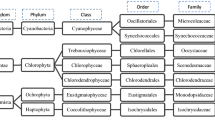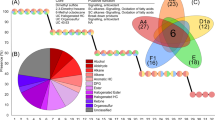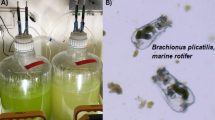Abstract
Small amounts of C1–C8 volatile organic compounds were found in macroalgae in concentrations high enough (generally in the range of 1–400 times those in sediments) to suggest that the seaweeds are a source for some of the volatile organic compounds identified in recent marine sediments. The types of compounds identified1–4 include alkanes, alkenes, aldehydes, ketones, furans, and sulphides. Both the light hydrocarbons and the volatile functionalized organic compounds are believed to originate from living organisms and from both biological and chemical low-temperature reactions in the sediments. Understanding their mechanism of formation may help in deciphering the thermal and biological history of the sediments. Traces of some of these compounds can be produced from bacterial degradation of naturally occurring terpenoids5. We consider here their occurrence in algae.
This is a preview of subscription content, access via your institution
Access options
Subscribe to this journal
Receive 51 print issues and online access
$199.00 per year
only $3.90 per issue
Buy this article
- Purchase on Springer Link
- Instant access to full article PDF
Prices may be subject to local taxes which are calculated during checkout
Similar content being viewed by others
References
Hunt, J. M. Nature 254, 411–413 (1975).
Hunt, J. M. & Whelan, J. K. Org. Geochem. 1, 219–224 (1979).
Whelan, J. K., Hunt, J. M. & Berman, J. Geochim. cosmochim. Acta 44, 1767–1785 (1980).
Whelan, J. K. & Hunt, J. M. Init. Rep. DSDP Leg 56–57, 1349–1365 (1980).
Hunt, J. M., Miller, R. J. & Whelan, J. K. Nature 288, 577–578 (1980).
Whelan, J. K. Gas Chromatography/Mass Spectrometry Applications in Microbiology (eds Odham, G., Larsson, L. & Mardh, P. A.) (Plenum, New York, in the press).
Hunt, J. M., Whelan, J. K. & Huc, A. Y. Science 209, 403–404 (1980).
Faulkner, D. J. & Fenical, W. H. Marine Natural Products Chemistry (Plenum, New York, 1977).
Scheuer, P. J. Marine Natural Products (Academic, New York, 1978).
Schoener, A. & Rowe, G. T. Deep Sea Res. 17, 923–925 (1970).
Honjo, S. J. Mar. Res. 38, 53–97 (1980).
Sorokin, Y. I. The Changing Chemistry of the Oceans (eds Dryssen, D. & Jangner, D.) 189–204 (Wiley, New York, 1972).
Baker, J. T. & Murphy, V. Handbook of Marine Science Vol. II (CRC Boca Raton, 1981).
Heller, S. R. & Milne, G. W. A. EPA/NIH Mass Spectal Data Base, Vol. 1 (U.S. Government Printing Office, 1978).
Moore, R. E. & Yost, G. Chem. Commun. 937 (1973).
Hunt, J. M. Petroleum Geochemistry and Geology, 91 (Freeman, San Francisco, 1979).
Author information
Authors and Affiliations
Rights and permissions
About this article
Cite this article
Whelan, J., Tarafa, M. & Hunt, J. Volatile C1–C8 organic compounds in macroalgae. Nature 299, 50–52 (1982). https://doi.org/10.1038/299050a0
Received:
Accepted:
Published:
Issue Date:
DOI: https://doi.org/10.1038/299050a0
This article is cited by
-
Effects of Methyl Jasmonate on the Composition of Volatile Compounds in Pyropia yezoensis
Journal of Ocean University of China (2018)
-
Determination of acetone in seawater using derivatization solid-phase microextraction
Analytical and Bioanalytical Chemistry (2007)
-
Determination of selected atmospheric aromatic hydrocarbons at remote continental and oceanic locations using photoionization/flame-ionization detection
Journal of Atmospheric Chemistry (1985)
Comments
By submitting a comment you agree to abide by our Terms and Community Guidelines. If you find something abusive or that does not comply with our terms or guidelines please flag it as inappropriate.



